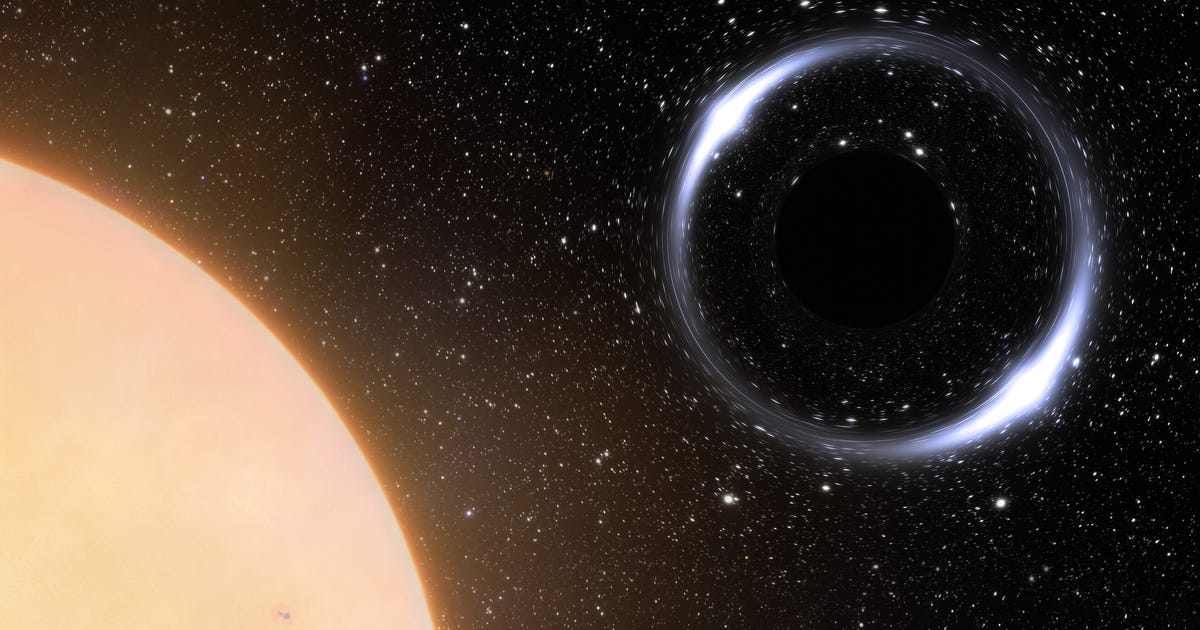
Black holes are awesome and powerful and can seem a bit scary thanks to their reputation for gravitational pulls so strong not even light can escape. So let’s give a big welcome to Gaia BH1, the new closest black hole to Earth.
Gaia BH1 is dormant, 10 times more massive than our sun and located about 1,600 light-years away in the constellation Ophiuchus (the serpent-bearer). The team behind the discovery says it’s three times closer to Earth than the previous winner, a black hole located in the Monoceros (unicorn) constellation. Gaia BH1 is close enough that the National Science Foundation’s NOIRLab astronomy center considers it to be “in our cosmic backyard.”
“While there have been many claimed detections of systems like this, almost all these discoveries have subsequently been refuted,” said astrophysicist Kareem El-Badry in a NOIRLab statement Friday. “This is the first unambiguous detection of a sun-like star in a wide orbit around a stellar-mass black hole in our galaxy.” Stellar-mass black holes are within five to 100 times the mass of our sun, as compared with supermassive black holes that live in the centers of galaxies.
El-Badry is the lead author of a paper on the black hole published in the Monthly Notices of the Royal Astronomical Society journal this week. The lengthy co-author list points to how complex and challenging the study was. Finding this black hole was a science triumph with many layers.
The story starts with the European Space Agency’s Gaia space observatory, which is cataloging the stars of our Milky Way galaxy. Researchers searching through Gaia data spotted a star very much like our sun that showed a distinctive wobble, suggesting something was tugging on it. That something turned out to be the dormant black hole.
Dormant black holes are hard to spot because they’re not making a big ruckus (like this black hole spitting out cosmic jets); they’re just chilling out. “The sole reason this black hole could be found was due to Gaia’s ability to see the position of the star (that is orbiting about it) with such a high precision,” wrote Gaia team member Tineke Roegiers in an ESA statement Friday. “This position wobbles about when the star moves around the black hole.”
What is a black hole? The universe’s dark, mysterious monsters
The Gaia sighting was just the beginning. The astronomy team turned to other telescopes to scope out the discovery. The Gemini North telescope operated by NOIRLab in Hawaii played a key role by letting the team make precise measurements of the orbit of the star spotted by Gaia. “We could find no plausible astrophysical scenario that can explain the observed orbit of the system that doesn’t involve at least one black hole,” said El-Badry.
Black holes like this form from the collapse of massive stars, so Gaia BH1 and its companion star make up a binary system. The system’s formation and evolution is a bit of a mystery. Roegiers described the black hole as “quite special,” saying, “It is different from all other known black holes, and its existence is difficult to explain with standard binary evolution models.”
NOIRLab estimates there could be 100 million stellar-mass black holes in the Milky Way, though very few have been confirmed. The discovery of Gaia BH1 is an important step toward locating and understanding quiet black holes that aren’t loudly announcing their existence to the cosmos.
So welcome to the neighborhood, Gaia BH1. This could be the start of a new understanding of how binary star systems evolve. It goes to show that dormant doesn’t mean boring.

